1 Introduction
This article refers to the address: http://
In 1997, Honda developed the first generation of IMA (Integrated MotorAssist) system. In December 1999, the Insight-equipped IMA system was officially launched in the US, and Honda became the first company to sell hybrid vehicles in North America. In 2003, the four-door small car civic equipped with the second-generation IMA system was put on the market and was well received by consumers. The Honda Accord Hybrid became the hybrid midsize sedan equipped with the third-generation IMA system and became the world's first hybrid midsize sedan.
Recently, Honda has applied the newly developed fourth-generation IMA hybrid system to the 2006 civic hybrid. Honda's latest IMA hybrid technology is also the only high-end technology that can be applied to existing production models. In this field of research and development, Honda has always maintained a leading position on a global scale.
2IMA system introduction
2.1 IMA system composition
The main components of the fourth-generation IMA system are a 1.3-literi-VTEC4-cylinder gasoline engine, a high-power ultra-thin permanent magnet synchronous motor, a continuously variable transmission (CVT) and an intelligent power unit (IPU-IntelligentPowerU-nit). The IPU consists of a power control unit (PCU-Powercon-trolUnit), a set of high-performance nickel-metal hydride batteries and a refrigeration unit. The gasoline engine and the motor are arranged at the front of the vehicle, and the intelligent power unit is arranged at the rear of the vehicle. The specific structure is shown in Fig. 1.
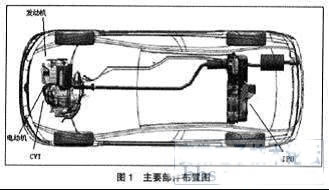
2.2 IMA system working process
a. Start acceleration: The engine runs at a low speed valve timing while the motor provides auxiliary energy.
b. Accelerated state: The engine is running at high speed valve timing. At this time, the battery will provide additional power to drive the motor together with the engine to improve the acceleration performance of the vehicle until the battery condition monitoring module (BCM? Battery Condition Module) The battery was found to be low and the battery charge command was turned off.
C. Low-speed cruising state: All four cylinder valves of the engine are closed, combustion stops, and the vehicle drives the vehicle in a purely electric state.
d. General acceleration or high speed cruising: The engine is driven separately at a low speed valve timing.
e. Deceleration state: The engine is turned off and the motor acts as a generator at this time. With the help of the electric control transmission system, the mechanical energy is converted into electrical energy to the greatest extent and stored in the battery pack.
f. Parking status: The engine is automatically shut down to reduce fuel loss and emissions.
3IMA analysis
3.1 engine
The 2006 Civic Hybrid 1.3L engine is based on the 2005 1.3Li-DSI engine and has been improved. Mainly using i-VTEC and intelligent dual spark plug sequential ignition technology (i-DSI) and variable cylinder management technology (VCM), achieving ultra-low fuel consumption and improved fuel economy. The new system provides the timing of the gas distribution in the low-speed, high-speed and intermittent modes. The four cylinders are all intermittent, which can improve the energy recovery efficiency during deceleration. It is the most advanced valve control technology.
3.1.1i-VTEC (intelligent-VariableValveTimingandLiftElectronicControlSystem) system
VECT (VariableValveTimingandLiftElectronicControlSystem) can change the valve timing and valve lift electronic control technology, adjust the rocker piston hydraulic system through the solenoid valve, so that the engine is controlled by different cams under different speed conditions, affecting the intake valve Opening and time. At low engine speeds, a reasonable eddy current ratio is created by the difference in lift between the main intake and auxiliary intake valves for good performance. The high power output of the conventional 4-valve engine is maintained at high speed. This allows the engine to maintain high power output while maintaining low fuel consumption.
The i-VTEC system adds a variable timing control system (VTC-valveoverlapcontrol) to the VTEC system, i-VTEC=VTEC+VTC. The ECU control program adjusts the opening and closing of the intake valve to make the valve overlap time more accurate, achieve the optimal intake and exhaust timing, further improve the engine power, and help the engine to reduce energy loss when the vehicle decelerates.
3.1.2 Intelligent double spark plug sequential ignition i-DSI system
The intelligent double spark plug sequential ignition i-DSI system changes one spark plug control ignition mode of one cylinder to two spark plugs on one cylinder, which are respectively set on the intake side and the exhaust side, which shortens the flame in the combustion chamber. The time of propagation realizes rapid combustion in the whole domain, and at the same time reduces the tendency of explosion and explosion, making it possible to greatly increase the compression ratio, achieving the unification of high output power, high output torque and low fuel consumption.
Honda's unique dual spark plug continuous control system is based on engine speed and load conditions. When the fuel compound enters the combustion chamber, the first spark plug near the population ignites. Soon after, a second spark plug near the exhaust ignites to promote the combustion process. This system makes combustion more complete than a single spark plug system. The engine delivers more power, less fuel consumption, and lower emissions.
.


3.1.3VCM (variablecylindermanagement) can change cylinder management technology
The new VCM system is an improvement of the previous generation 3-cylinder batch system, which allows all four cylinders to be intermittent. The motor (also acting as a generator) is attached to the engine's crankshaft, and the engine needs to provide as little resistance as possible during deceleration, allowing the motor to charge the battery more efficiently. Conventional engines, when decelerating, the cylinder piston will provide some resistance, or (engine braking). VCM will eliminate this effect, allowing the regenerative braking system to recover as much energy as possible.
3.2 motor
The MA motor is a 3-phase ultra-thin permanent magnet synchronous motor that is installed between the engine and the CVT (CVT) to provide up to 15 kW of power and 139 Nm of auxiliary torque. The electric motor provides an auxiliary driving force to the engine and the motor power at low speeds, and also acts as a generator to recover kinetic energy to decharge the battery during deceleration and braking. The power of the vehicle is greatly improved by the assistance of the motor, and the power curve is shown in Fig. 4.
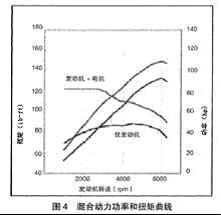
The motor uses a state-of-the-art coil winding configuration that is more densely wound. This resulted in a 50% and 14% increase in the maximum power and maximum torque of the motor compared to the 2005 version of the civic hybrid motor, and the conversion efficiency increased from 94.6% to 96%. Honda has separately developed an inverter for controlling the speed of the motor. It is integrated with the ECU (embedded control unit) of the motor and uses digital communication to make the control more accurate, which improves the efficiency of the motor. Fuel economy of hybrid systems.
3.3 battery
The battery is an important part of the hybrid system. The amount of stored electricity is directly related to the cruising range of the car. The new hybrid system uses the newly developed high-efficiency nickel-metal hydride battery, which has a 30% higher storage capacity than the previous generation. The battery voltage has been raised from 144 volts to 158 volts. The specially designed battery case is compact, cooling and shock absorbing. The sex is also better, which guarantees the long-term stable operation of the battery. The new Panasonic's dual-mode package reduces weight and increases current efficiency compared to the previous generation, reducing volume by 12% and saving more space.
3.4 hybrid air compressor
Civic's in-vehicle air conditioners use a specially designed "hybrid" air compressor that can be driven by the engine, driven by an electric motor, or both. When the engine is not working, the motor can drive the compact air compressor to continue working to ensure the temperature inside the car. If the outside temperature is particularly high, high-speed cooling is required. When the motor drive alone is no longer possible, the engine system will automatically start, and the cold air will be continuously supplied to the vehicle. When the temperature inside the car has stabilized to the optimum level, the engine will automatically shut down, saving fuel consumption.
3.5 Regenerative braking system
The IMA motor can act as a generator during braking, steady travel, slow deceleration, or taxiing, recovering kinetic energy through regenerative braking and storing this energy in the battery in the form of electrical energy. When braking, the brake pedal sensor gives the car an IMA computer (IPU) a signal. The computer activates the servo unit in the brake master cylinder of the brake system to equalize the braking force between the mechanical brake and the motor energy feedback for maximum energy feedback. Honda's original IMA system was a fixed brake energy distribution ratio that was lower than the maximum energy feedback and had no variable ratio. The new system relies less on traditional braking systems and reduces engine energy losses. The energy recovery capacity is increased by 70% compared to 2005civic, and the fuel supply is more economical.
3.6 system control
The power of the IMA system is controlled by the Intelligent Power Unit (IPU), which is located under the rear wheel seat. The IPU consists of a Power Control Unit (PCU), a rechargeable Ni-MH battery module and a refrigeration unit. Figure 5 shows.
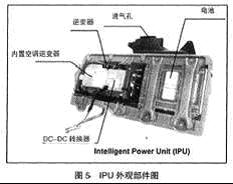
As the core part of the IPU, the PCU controls motor assistance, brake feedback and battery (including IMA battery pack and 12V battery) charging and discharging. The PCU determines how much power is assisted by the throttle opening, engine parameters, and the state of charge of the battery pack. The main components are battery monitoring module (BCM-BatteryConditionMoni-tor), motor control module (MCM-Motorcontrolmodule), motor drive module (MDM-motordrivemodule). The fourth generation uses the latest computer chip technology, and the PCU reflects faster than any previous generation. The newly developed inverter and DC-DC converter help the IMA system to fully increase its maximum power. The complete refrigeration system reduces the heat generated by the current in and out of the battery pack. The refrigeration system module is mounted outside the battery compartment and the air in the internal enclosure constantly overflows from the air duct under the rear seat.
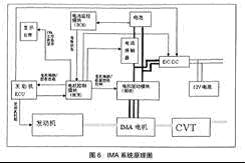
3.6.1 Battery Monitoring Module (BCM-BatteryConditionMonitor)
The battery information monitored by the battery monitoring module mainly includes: SOC, battery protection demand information, battery temperature, and the like. The main battery is monitored by a temperature sensor, a voltage sensor and a current sensor, the charge and discharge ratio is measured, and information is supplied to a motor control module (MCM). The BCM controls the IMA battery pack's state of charge to operate in an ideal state (20% to 80%) while preventing additional power consumption and battery overcharging. The battery monitoring module controls the operation of the battery cooling fan at the same time.
3.6.2 Motor Control Module (MCM-Motorcontrolmodule)
The MCM controls the various behaviors of the motor. The MCM is a low-voltage computer whose main functions are (1) communication with the engine control module (ECM-EngineControlModule) to determine the operating state of the vehicle and to detect problems detected in the IMA system. Transfer to ECM. (2) Communicate with the battery monitoring module BCM to obtain the state of charge of the battery module. This information is used to protect the battery module and maintain proper charge balance. (3) Connected to the instrument panel, always showing information about IMA system conditions and operating status. (4) Connect with the motor drive module MDM to receive the rectification information of the motor, and control the motor power converter (MPI-MotorPowerInverter) through the voltage conversion module.
3.6.3 Motor Drive Module (MDM-motordrivemodule)
The motor drive module controls the motor to assist the engine and charge the battery, which enables bidirectional transfer of current between the motor and the battery. The interior is mainly a motor power converter (MPI) and voltage control unit. When the motor is in the auxiliary state, energy is transferred from the battery module to the motor through the MPI conversion from DC to 3-phase AC. At the same time, the MCM receives the feedback information of the three motor rectification sensors, obtains the state information of the motor, and ensures the correct operation of the motor by controlling the phase of the 3-phase current at an accurate time. The voltage conversion module receives the command of the motor control module (MCM) to meet the requirements of the system by controlling the opening and closing of the insulated gate bipolar transistor. During braking, the current flows from the motor to the MDM. The motor produces 3-phase AC power, which is converted to DC by MPI to charge the battery.
3.7 Comparison with previous generations
Table 1 shows the comparison of the two hybrid system parameters of the civic 2006 equipped with the fourth generation IMA and the previous generation civic2005. It can be seen from the comparison with the previous generation products that the selection of main components has not changed. The engine, motor and control system have been improved by adopting the latest technology, which reduces the power of the system while reducing the space of each component. Fuel and emissions have also been greatly improved.
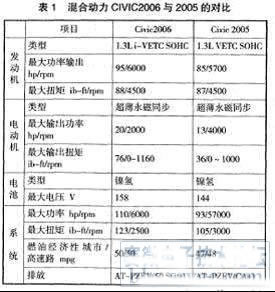
4 summary
As a hybrid car already on the market, civic2006 has advanced technical features and good overall vehicle performance. This paper reveals its basic design ideas and working principles through the analysis of the working characteristics and main components of Honda's fourth-generation hybrid system. It has certain reference for the research and development of domestic mild hybrid hybrid vehicles.
Corn Sheller,Hand Corn Sheller,Corn Sheller Machine,Hand Crank Corn Sheller
Hunan Furui Mechanical and Electrical Equipment Manufacturing Co., Ltd. , https://www.thresher.nl